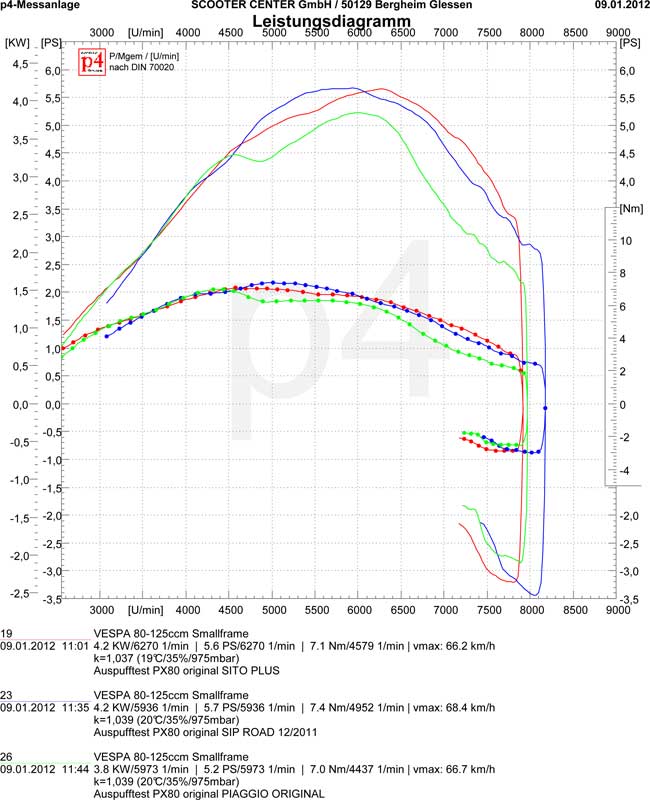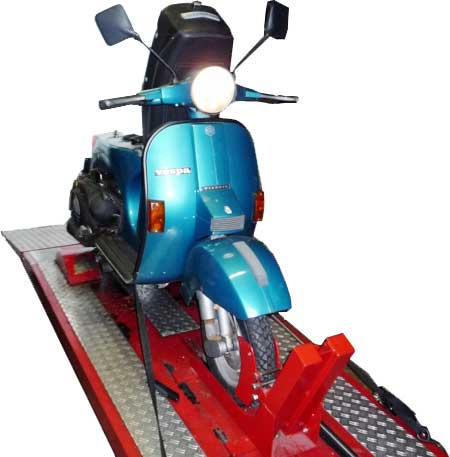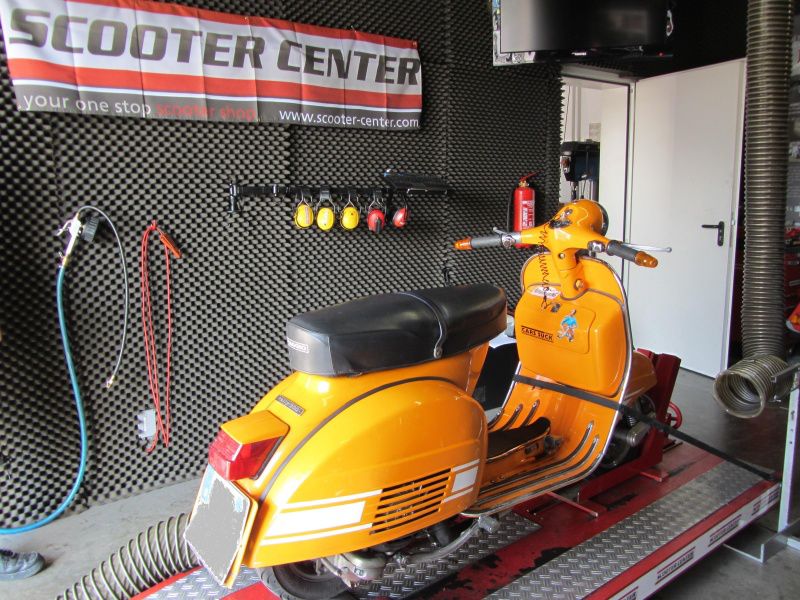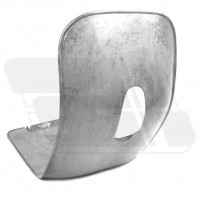Small Vespa exhaust test Vespa PX80 original
Vespa exhaust test
As part of our development of the 125cc cylinder for the PX80, different exhaust systems were tested on a completely original PX80 in order to have references available for comparison.
We tested the following exhaust systems:
Original Piaggio (green curve)
SITO Plus (red curve)
SIP Road (blue curve)

It is remarkable how brave the Sito Plus does against the strong Road. Up to 4500rpm, the original pot is not only at eye level but even a little bit stronger to then say goodbye to the other two in a spectacular way.
As expected, surprises cannot be expected from an exhaust change on such a tame cylinder. The absolute numbers only result in a difference of a maximum of half a horsepower.
However, it is more important to consider the performance curve here. So the engine with the Sito Plus at 7000rpm still has a remarkable 5HP on the rear wheel, the original pot only has 3,5HP.
The 7000 rpm correspond to approx. 80 km / h in fourth gear (the diagram shows measurements in third gear). So there are only 2,5 HP more on the rear wheel by changing the exhaust with the Sito Plus.
The result is that the motor can maintain this speed much better without being forced to its knees by increased driving resistance such as an incline or headwind.
The SIP Road, on the other hand, has more torque in absolute terms, but this is applied much earlier and, in direct comparison to the Sito Plus, is only noticeable in the draft or mid-speed.
Here, the final translation might have to be lengthened somewhat in order to utilize the full potential of the system.









Has the sprinkler been adjusted?
We tried it, but didn't bring any noteworthy changes.
Ie all curves were with the orig. PX80 spraying (HD95) made.
Greetings Uwe
Hallo,
how fast should the PX80 with SIP Road or Sito Plus be? I have already used both systems on a P80X and although I was able to determine a noticeable increase in performance compared to the original exhaust, the top speed according to the PX old speedometer was never more than 73-75 km / h under the best conditions (spraying was adapted to HD98 and air filter has holes over HD and ND). I had hoped that by replacing the exhaust I would achieve a top speed of around 80km / h, but unfortunately I'm far from that.
From your experience, is the top speed OK, or do I have to assume that something is wrong with my P80X (piston rings worn ...)? What simple “Plug & Play” changes could I make to increase the top speed (Polini Venturi air filter, ..)? Could a 21 coupling be used with the SIP Road? Is there a 3.5-10 tire that would also slightly increase the gear ratio if it were larger?
LG Thomas
Hello Thomas,
From approx. 70-80km / h, the general driving resistance is also greatly aggravated by the air resistance.
This means that from this speed range onwards, the power applied to the rear wheel is no longer converted into top speed as quickly as, for example, in the range of 40-50km / h. In other words, any increase in rear wheel performance in the relevant speed range always results in an increase in top speed. As an example from practice I can name for example: Piaggio SKR 125 (automatic), completely original, has a little over 80HP on the bike at 10km / h, and only 90HP at 9,5km / h. Although the SKR has a very 'smoothly sucked' front, which means that there is little surface to attack the air resistance, the thing actually hardly drives more than 90 km / h. Only when the driving resistance is minimized (slight gradient, slipstream, etc.) does it drive significantly faster and, according to the speedometer, scratch the 100 km / h mark. In other words, this should serve as a comparison or estimate how much power is required for, for example, a real 90km / h. Speak with 5PS at 80km / h (PX80 with Sito Plus) you are still relatively lean and can only hope for favorable conditions for a higher top speed.
But what I would try would be to use an undrilled air filter. Boring often also messes up a lot in the mixture formation, which has to be compensated for by a modified main air correction nozzle. This means that the premix may be too lean despite the larger main jet and the engine's performance drops steeply in the upper speed range, although it has much more potential.
Gimmicks like another air filter or similar are not worthwhile in my opinion, since the carburetor / inlet is not a throttle point.
In other words, if you want to get faster on the basis of the original cylinder, you have to revise it for better or worse, i.e. first determine the basic data (control angle, compression ratio, channel areas, etc.) in order to then optimize the engine accordingly.
Ultimately, there is very little that could be changed without a deeper understanding of the two-stroke cycle so that the conversion to another cylinder is easier and much more effective.
Greetings Uwe
Hello Uwe,
Thanks for the detailed answer. I would still be interested in how fast the PX80, which was used in your exhaust test, drives. Can the maximum speed of 77 km / h specified in the papers be achieved in the original state?
LG Thomas
Hello Thomas,
We are currently only driving the 80cc variant on the test bench.
Basically, a PX80 reaches the entered 77km / h, but usually only with a lot of startup and depending on the condition of the motor.
Even a worn out alternator shaft seal can make the thing so lean that there is a lack of possible top speed.
At that time I reached 90km / h on the autobahn, but only in the slipstream;)
Greetings Uwe
Hi,
I've been driving the SITO PLUS for a long time on a slightly optimized PX on a long stretch.
How about a comparison test PX 200, optimized with the three systems (Sito - SIP Road-Original).
If my mill were to be made available, it would also be a powerful statement for the question: ORI SITO & SIP!
Tussi Rommel
Hallo,
Drive a PX80 in series production with a 98 main jet.
Now I'm thinking of installing a sports exhaust.
Do I still have to change the main jet so that it doesn't run too lean?
What other changes or what exhaust would make sense?
gruß
Sebastian
Hi Sebastian,
To be on the safe side, I would always jet a little higher after installing a different exhaust. Compared to other systems, the Sip Road in particular always requires a slightly heavier spray. In this particular case, however, I would prefer the Sito Plus. This offers the highest top speed, but is also a bit louder than a Sip Road.
gruß
Hello Uwe,
Thank you very much for the quick response.
However, I still have a question about the main jet. I am now driving the 98 HD and have decided to buy a Sito Plus based on your recommendation.
How big should I choose the nozzle or would the 98 be sufficient. I am a newcomer to Vespa and therefore unfortunately inexperienced in this area.
gruß
Sebastian
Hallo,
The original is a 1984 main jet in the PX Lusso (from 95), the old PX (up to and including 1983) used a 96. Ie with the 98 you are already on the safe side. I always drove the SitoPlus with the original spraying.
Greetings Uwe
Hi,
I would be interested in whether the Sito Plus can also be registered with the TÜV?
Greetings Bernd